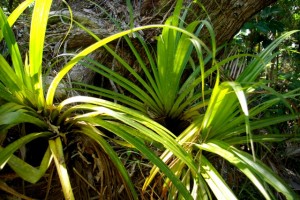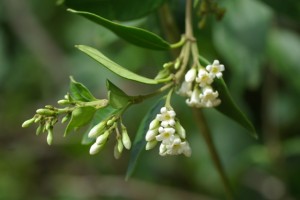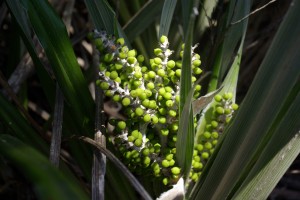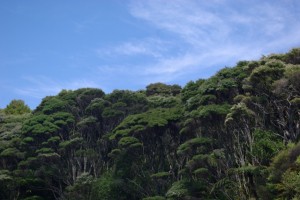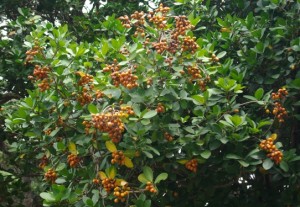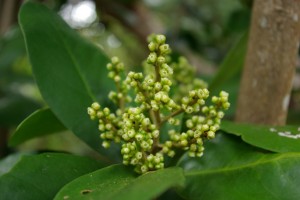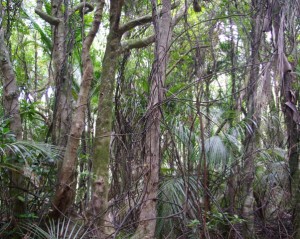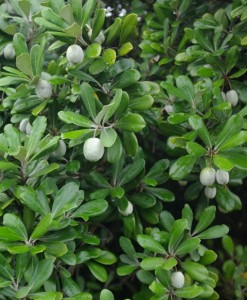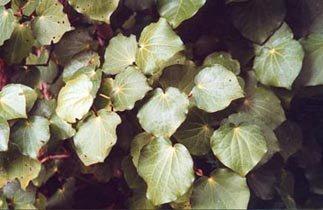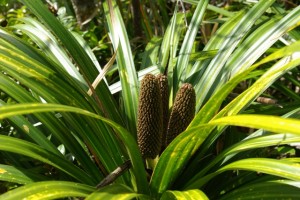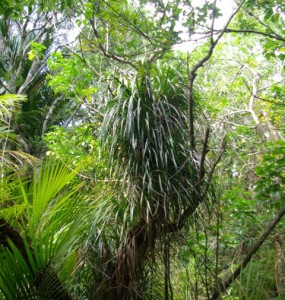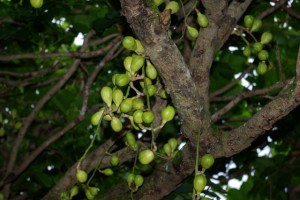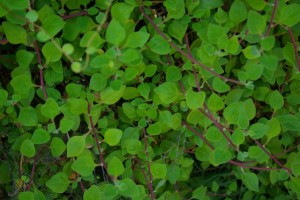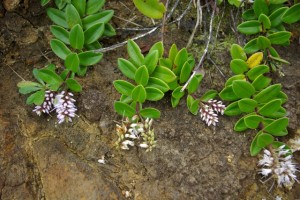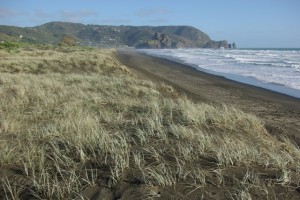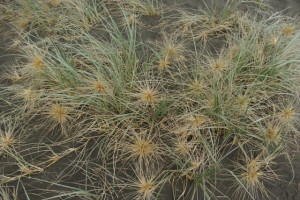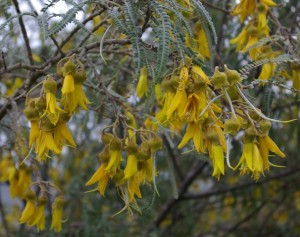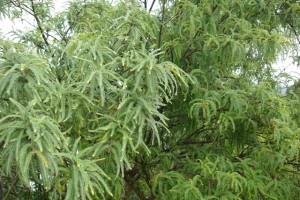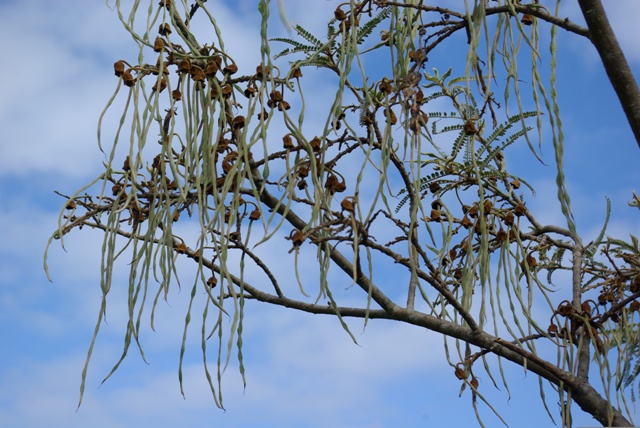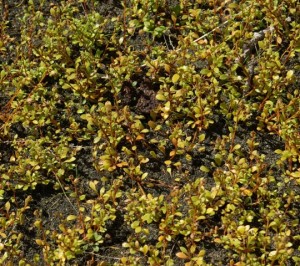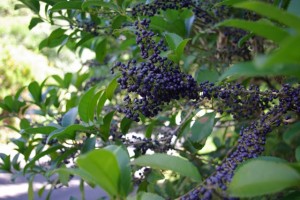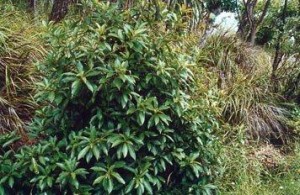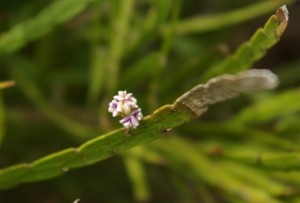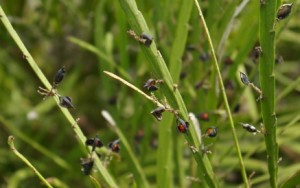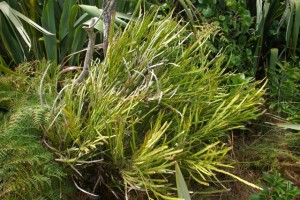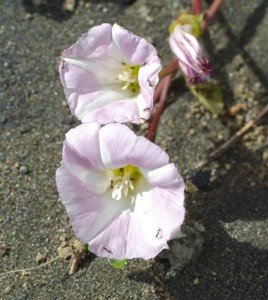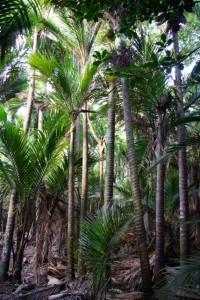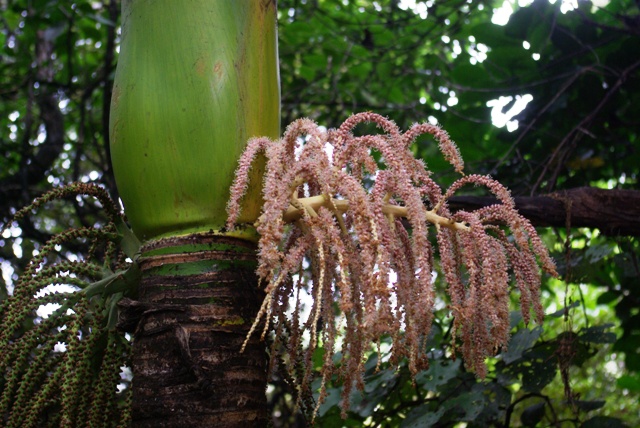Kahakaha or tank or perching lily
Collospermum hastatum family Liliaceae
A common epiphyte throughout lowland forest in the North Island and in the north of the South Island, it is distinguished by its fan-shaped habit and black colour at the base of the yellowish-green leaves. The tight base of the plant holds rainwater, and some native mosquitos breed in it. Unlike astelias, the sleeves are stiff and grow up straight. This clump was photographed in an old pohutukawa on our property.
The flowers or inflorescences are large with pale yellow flowers followed by translucent berries that turn red. They flower in mid-summer and berries appear in autumn and winter.
If the plants fall or blow off trees they continue to grow on the ground.
Kaihua or kaiwhiria Maori jasmine
Parsonia heterophylla family Apocynaceae
This is a vigorous climber with soft green stems that can climb up to 10 metres or more. The stems often twine one around another to ascend in a rope-like fashion. Kaihua is capable of smothering reasonable sized trees and can form such a heavy mat on trees that it may even weigh down a kowhai or mahoe. It is often found in coastal situations and on the margins of bush.
Kaihua has oval mid-green leaves in its adult form. The juvenile leaves vary considerably, hence the name heterophylla.
The small, fragrant white flowers are born profusely in trusses through the summer months. They develop into thin dangling bean-like pods, which in autumn split open and release their seeds which are carried away by the wind.
Kakaha or bush lily or bush flax
Astelia fragrans family Liliaceae
This common plant forms large dense clumps on the forest floor giving our native bush rather a tropical appearance. It is found from sea level to about 900m. The stiff sword-like leaves are usually bright or deep green, and the underside can be silvery caused by tiny scales. Sometimes the midrib of the leaves can be red. They store water in the base of their leaves so tend to be unaffected by summer droughts.
The flowers of kakaha appears in October to November and consist of many panicles, similar to the cabbage-tree, with small green highly fragrant flowers. The flowers are in the centre of the tuft. The flower develops into yellow-orange fruit, looking like sweet corn, which are enjoyed by the birds.
In older books like Laing and Blackwell’s Plants of New Zealand, astelia fragrans will be described as A. nervosa. Astelia means a plant without a stem.
Kanuka or teatree
Leptospermum ericoides family Myrtaceae
It gets called scrub, but I’m a great lover of the tough, grey kanuka tree that plays such a key part in the regeneration of New Zealand native bush. To me, there’s no finer sight than a iconic stand of coastal kanuka, sculpted by the wild westerly wind.
Kanuka can adopt many forms according to the location, from stunted and twisted coastal cover to spreading tree. It is taller than manuka and can grow to 15 metres in height and the trunk has distinctive stringy silvery-grey bark. The red wood was used by Maori for many purposes including weapons and Pakeha have used it for a multitude of purposes including fence posts and firewood. It burns readily and throws out a good heat. These prosaic purposes might explain why New Zealanders don’t fully appreciate the importance of kanuka to landscapes and to the regeneration of native bush.
The leaves are very small, elongated and grey-green, and the small white flowers can smother the tree during the flowering season from September to February. The hard seed capsules contain a myriad of fine hair-like seeds which can take two years to develop and be shed. Kanuka often grow in stands close together and as they age they break down, thus providing shelter and gradual increasing light for broadleaves coming away underneath. Like manuka, kanuka are an excellent nursery crop in bush regeneration.
Propagation is the same as for manuka below.
Karaka
Corynocarpus laevigatus family Corynocarpaceae
Karaka is a large coastal canopy tree with rich shiny green leaves and distinctive large yellow fruit which can smother the trees. A karaka in fruit is a fine sight. It grows in dense forest, or in semi-exposed coastal forest or in the open as specimens. It is beloved of the kereru, the native wood pigeon, which can get quite tipsy on the fruit.
The karaka grows quickly and can reach 16 metres in height, but it can also suffer from wind burn of growing tips and die back. It is a solid tree with a stout trunk and whitish bark. The leaves are oval and thick and almost reflectively glossy. The white flowers, born in sprays in spring, are white but not particularly striking. The fruits are the glory of the karaka. They ripen from January to April and are large and oval, born in trusses. They colour from green to lemony yellow to orange as they ripen. They can litter the ground under trees causing a nasty smell as they decay. The outer flesh is much enjoyed by birds who will gorge on them in the trees or on the ground.
The karaka was planted by Maori because it was an important food source. They had to process the fruits by steaming and washing to remove a particularly lethal poison in the husks. The karaka kernels are large with a fibrous cover. Maori also used the showy leaves to make headdresses for tangi. Interestingly, early Pakeha settlers dubbed the karaka the laurel because of its similarity to that tree which was also used for funerary decoration.
In its natural state the seeds of the karaka germinate easily around the parent tree and it is easy to dig these up for replanting. However, growing karaka from seeds is also particularly satisfying. First step is to soak the fruits in water for a couple of weeks and then rub the rotten flesh off. This is smelly mucky work but it isn’t hard to get down to the white fibrous kernel. These are then dried. They should be used fairly quickly because they do not stay viable for long. They need to be stratified before planting by putting in the fridge for 6-8 weeks, mixed with some damp sand and put in a plastic bag or jar, before planting in spring. Or you could put then straight into deep seed mix but they could take a year to show some life. You need to allow for the strong tap root that comes away by putting in seed mix to a depth of about 5 inches. The green shoots emerge vigorously and they are not delicate as seedlings. When you have about 4 leaves, you can carefully re-pot into a fairly large bag. Muriel Fisher suggests sowing seed straight into the ground which is another option if your soil is good.
Kareao or supplejack
Ripogonum scandens family Smilacaeae
Supplejack is a vigorous climber that is found in lowland forest throughout New Zealand.
In some places it presents a dominant entanglement of vines that descend from the canopy that is nearly impenetrable. The effect is rather reminiscent of dense South American forest. As a child I found the dense supplejack forest of the Byers Track at Piha totally mysterious. The vines varied in thickness from rope-like to much thicker and the effect was ancient and exotic.
The stems of supplejack are dark brown or black that have knots at the nodes where the leaves have been like bamboo. The stems climb up each other to a great height. At the high point of the stems, in the lighter areas of the forest canopy, there are slender elegant green leaves. The flowers are inconspicuous but the berries, wich appear through much of the year, are bright red a bit like holly.
Maori used the stems for purposes such as ladders and eel traps, and other parts of the plants for medicinal purposes, while early Europeans used the root to concoct a kind of sarsaparilla.
Karo or Turpentine Tree
Pittosporum crassifolium family Pittosporaceae
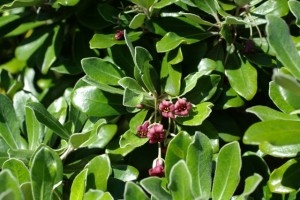 This common coastal tree is much under-valued, it seeds profusely, establishes easily and is handy in any coastal regeneration project. In our revegetation project we have found it invaluable. It grows quickly, but is reasonably robust at withstanding strong prevailing winds. As it grows strongly, and is taller, it provides shelter for other pioneer species and pulls up the growth around it, creating taller bush more quickly.
This common coastal tree is much under-valued, it seeds profusely, establishes easily and is handy in any coastal regeneration project. In our revegetation project we have found it invaluable. It grows quickly, but is reasonably robust at withstanding strong prevailing winds. As it grows strongly, and is taller, it provides shelter for other pioneer species and pulls up the growth around it, creating taller bush more quickly.
The karo is small tree reaching up to 9 metres in height, the leaves are a mid grey-green and the undersides have white hairs or tormentum. In this respect they are similar to the pohutukawa, and to the untutored eye, a young pohutukawa can be confused with a karo, especially cultivated pohutukawa which suffer from the modern trend to grow them with a trunk.
The thick leathery leaves enable the karo to withstand strong salt-laden wind and not dry out.
During September and October the karo bears trusses of deep maroon flowers with folded back petals. They are not striking on the tree but attractive on close inspection. They are strongly perfumed so a heavily flowering karo can leave a delicious fragrance on the night air.
Large grey-green seed capsules develop from the flowers. These burst open to show three or four compartments containing masses of black seeds in a sticky bright yellow glutin.
To grow karo, pick the capsules and put in a plastic bag with a handful of sand – fine black iron sand is best. Shake the bag, then rub the seeds out of the capsules. It is dirty work but less trouble than many other native plant seeds that need to have their flesh removed.
The seeds can be put in a jar with more sand and put in the fridge for six weeks or so. Then plant in a seed tray in the usual way.
Kawakawa
Macropiper excelsum family Piperaceae
The kawakawa is a densely branched shrub or small tree (up to 6 metres). It is a member of the pepper family and is related to the plant used in the Pacific to make kava, hence its name. The fruit and leaves are highly aromatic. The Maori used the leaves as poultices to treat bruises and decoctions of the leaves and fruit were used for treating toothache, boils and stomach ailments.
It is a common shrub that grows in forest under larger trees or on bush margins, although it dislikes a dry, exposed position. It grows quickly and its seeds will germinate profusely on the forest floor. The leaves are glossy dark green and shaped rather like the spade in a pack of cards. They tend to get eaten by insects so that the leaves of the kawakawa is commonly pocked with holes. Its branches are slender and red or black with notches at intervals.
The plants bears bright yellow-orange upright catkins much of the year. These are sought after by birds, particularly pigeon. Sometimes a kawakawa plant will not bear the full weight of a feeding pigeon and the branch will collapse under it.
Kiekie
Freycinetia baueriana subsp.banksii family Pandanaceae
Kiekie is called a vine but you are just as likely to find great dense growths of the plant scrambling on the ground over rocks and tree stumps as up in trees. More accurate is Muriel Fisher’s description of kiekie as a scrambling shrub.
As its species name suggests it is related to the pandanus found through the Pacific and it does have a tropical appearance. The leaves are used by Maori in the manufacture of woven baskets.
Kiekie likes lowland forest, and also swampy forest areas. It produces crowns, shaped a bit like the top of a pineapple, though with leaves that are shiney, slender and about 2 feet in length. The plant grows up the trunk of host trees to a considerable height using spreading roots, but the vines later swing free from the tree and a mass of roots attaches to the ground close to the trunk.
The plant can in time entirely shroud a tree. In the Waitakeres, the kiekie is particularly found in association with the kauri.
On the forest floor, kiekie can form dense masses which are difficult to negotiate, as the leaves have slightly razor edges and the stems create an interwoven mass that is difficult to get through.
Kiekie has large beautiful flowers that appear in spring/early summer. The fleshy white bracts of the fruit look a bit like pineapples and are like sweet marshmallow. They were a delicacy for Maori and for later European settlers living near the bush.
Kohekohe
Dysoxylum spectabile family Meliaceae
Kohekohe grows into a large handsome tree of 15 or more metres tall and can constitute extensive forests in wet coastal areas just in from the sea. There are remnants of kohekohe forest in parts of Piha, such as in the area bounded by Rayner Road and Sylvan Glade. There are also many kohekohe in the Nikau Glade Track area. Kohekohe wood is related to mahogany and its wood is light, strong and polishes to a fine red colour.
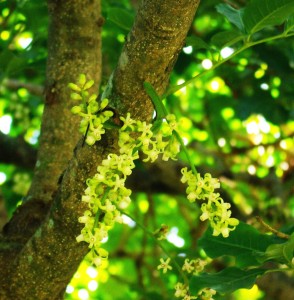
Kohekohe flowers arise straight out of the trunk, like this example from my favourite tree in Rayner Road
The trunk of the kohekohe is straight, topped by a spreading canopy. The roots can spread along the ground surface forming small buttresses.
The leaves of kohekohe are light green, shiny and handsome and have a strong unpleasant smell. The flowers grow directly out of the trunk in sprays of white waxy flowers, similar in shape to fuschia. You have to get under the tree to see these flowers and a tree in full flower can be a spectacular sight.
The flowers develop into green fruit that burst open in about July to September revealing orange aril or seed pods. Each contains a dark seed. Both flowers and seeds are liked by possum which is threatening in terms of their reproduction.
Kokihi or New Zealand spinach
Tetragonia tetragonioides family Aizoaceae
and Tetragonia implexicoma beach spinach
This fast-growing native ground cover herb has long soft stems and soft fleshy triangular to diamond-shaped leaves. The upper surface of the leaves is covered with a soft plush surface. The insignificant flowers appear in spring.
This is the plant that Captain Cook used to ward off scurvy in his crews, but it was not much eaten by Maori.
Kokihi is found in dunes and under coastal forest margins near the sea. It scrambles over the ground and rocks and may grow through low vegetation.
Beach spinach is very similar but has distinctive red stems and red berries. Both can be eaten but only small amounts are advised.
Both are members of the ice plant family.
Koromiko – Waitakere rock koromiko
Hebe bishopiana family Plantaginaaceae
A small, low, spreading hebe found only in the Waitakeres, especially in coastal locations where it grows on stream sides, damp rocky banks and partially shaded rocky outcrops. It can also be found protruding from astelia clumps on rocky outcrops.
In the Piha area it can particularly be found in the Anawhata Stream gorge.
The old stems are grey black, the younger stems are maroon in colour. The leaves are green but the young tips are also maroon-coloured.
Hebe bishopiana flowers for a long period and plants are rarely without flowers. The flowers are pale lilac and fade to white. It can be easily grown from seed.
Hebe bishopiana is classed as Nationally Vulnerable and is threatened both by weeds, especially pampas and Mexican daisy, and careless weed control. It was previously greatly threatened by mistflower but a biocontrol agent has reduced the growth of mistflower to the advantage of the hebe.
Hebe bishopiana is named after John Bishop, an early settler at Titirangi, who was a keep botanist.
Here is a sceintific paper from the NZ Journal of Botany, 1996, about hebe bishopiana publications-journals-nzjb-1996-127
Koromiko – hebe obtusata or veronica obtusata
Family Plantaginaceae
This hebe has a restricted distribution along the West Coast of Aucklanbd, from Muriwai to Huia, and at Kawhia, and is classed “Naturally uncommon”.
This specimen was one of many along the tracks around Mercer Bay, where it was growing, typically, on exposed rocky banks with sparse vegetation. It was also found growing through an astelia, and it commonly threads itself through other plants such as flax.
It is small, sprawling and low growing, hugging the ground. The blossoms, which are said to appear July to December (but this was April!), are short and lilac in colour, though the colour can vary.
Hebe obtusata can hybridise with hebe bishopiana which shares the same habitat. The Kawhia population is associated only with former pa site and it is therosied the plants may be deliberately planted by Maori.
Kowhangatara
Spinifex sericeus
Spinifex is a native sand binder that sends out long leafy runners on the foredunes, down to the high tide mark. The leaves catch the sand and get buried, then they simply send up more leaves, in this way creating stable dunes.
When large seas sweep away foredunes, spinifex acts to reform and stabilise the dunes. Dunes formed by spinifex are undulating and smooth.
Spinifex is a grass and the long elongated leaves are covered in soft silvery hairs. The large seedballs which appear over summer can be seen bowling along the dunes or beach in the wind. When these get caught and buried, they expel their seeds, thus ensuring the widespread propagation of the plant.
Spinifex is vulnerable to continuing heavy human trampling, and on back dunes to competition with non-native species such as lupins and marram grass.
The seeds come in big round seedheads like pompoms that can bowl along the beach in a wind. Once they get soggy or caught by the sand, they break apart and deposit their seeds in the new location. Not all plants produce these balls as there are male and female plants with different flowers.
Spinifex can be readily propagated through seeds, but it is also easy to embed the seed heads in the sand and create new growth this way, or they can be grown from cuttings.
Kowhai
Sophora microphylla family Papilionaceae
Almost the national flower of New Zealand, if it wasn’t the pohutukawa? It is so well known there isn’t even a common name. The Maori word kowhai, means yellow in Maori
The brilliant golden display of the kowhai heralds spring (September to early November). On our property, kowhai line the drive and close overhead and the sight in spring is magnificent, like a golden archway with the ground coated in yellow also.
Kowhai grows throughout New Zealand at the lower edges of forest, and on the West Coast of Auckland, it grows along clifftop edges as the photos taken at my property show. The tree grows to about 10 metres tall, and are many branched, often tangled when young. In many places, they are very susceptible to borer and can be short lived, falling apart at some stage.
The leaves consist of many leaflets born tidily side by side, about 20-40 each side. They can vary in colour from green to silver as the photo shows. This tangle of leaves on the edge of our lawn is actually two intertwined trees, the left one silvery and the right greener.
The tubular hanging flowers are brilliant yellow and are born profusely on trees, though not every season. The display is often accentuated by the loss of leaves before flowering, so the flowers can be born on quite bare stems.
The long pods form in the coming months and are a sight in themselves. When mature, they contain very hard deep yellow-brown seeds. To grow kowhai, these are removed from the dry pod and are best nicked or sand-papered to get them going. They can then be soaked and grown in seed trays. Naturally, the seed pods don’t release their seeds. Instead the whole pod drops on the ground and as the pod decays the seeds drop into the soil.
The coating of the seeds is very hard, and experiments with keeping seeds in water for 10 years, showed that even after that period, some seeds would germinate. Hence the seeds can wash long distances in rivers or sea and still grow where they eventually wash up.
Tui and kereru love the nectar of kowhai, and kereru, bless them, also like the young leaf tips and seed buds of kowhai. I have seen a big fat pigeon rip a tree in our back yard to shreds – hence very few flowers that season!
Maakoako or sea primrose
Samolus repens family Primulaceae
This tiny ground-hugging perennial herb is found creating large green or yellow carpets in the Whatipu Scientific Reserve. It is the only New Zealand member of the primrose family.
Maakoako likes salt marshes but will also grow on rocks splashed by the sea. The plants photographed here near Karekare were exposed after a long dry season in March 2011.
The carpets photographed are normally water-logged with salt water or even submerged under shallow water. It tolerate these conditions the plant has developed the ability to slowly excrete excess salt.
Maakoako has small green slightly fleshy leaves with stems that sprawl along the ground. It has tiny little star-like white flowers dotted about when it flowers. The flowering period is November to February but these were photographed after flowering had finished.
The plant is apparently easy to grow from seeds or division in rock gardens and is valued for its long flowering season.
Mahoe or whiteywood
Melicytus ramiflorus family Violaceae
The mahoe or whitey-wood is a very widespread shrub or small tree (up to10 metres) in bush, bush margins and open areas. It is undistinguished in many ways, lacking showy flowers or seed, but performs a very useful function in bush and regenerating bush. It is fire resistant and will often come away from the base after fire has passed over it.
Its common name comes from the whitish appearance of the bark. The leaves are serrated and dark green.
The tiny white flowers which appear in November to January come directly out of branches and twigs and develop into deep purple-black seeds.
These are ready by March or April, and if there has been a second crop of flowers, again in May or June.
The seeds are very easy to propagate. Simply scrape off the flesh after soaking in water and plant in seed trays.
Manuka or teatree
Leptospermum scoparium family Myrtaceae
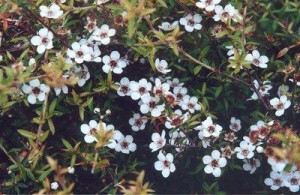 Manuka is commonly found all over New Zealand from the coast to about 1,000 metres and is naturally the first stage of regeneration of bush as long as imported weeds such as gorse don’t get in the way. Manuka forms a dense resilient shrub although it can grow to a tree of four metres in height. On our exposed coastal land at Piha, the manuka grows on a lean, bent by the wind. Where the wild westerlies hit hardest, it can be quite stunted, never growing above a few feet, each tree hugging its neighbour for protection.
Manuka is commonly found all over New Zealand from the coast to about 1,000 metres and is naturally the first stage of regeneration of bush as long as imported weeds such as gorse don’t get in the way. Manuka forms a dense resilient shrub although it can grow to a tree of four metres in height. On our exposed coastal land at Piha, the manuka grows on a lean, bent by the wind. Where the wild westerlies hit hardest, it can be quite stunted, never growing above a few feet, each tree hugging its neighbour for protection.
The leaves of manuka are small and when the leaves and branchlets are crushed they are aromatic. Oil derived from the plant is used for a variety of medicinal and cosmetic purposes. The flowers are white and larger than those of kanuka and appear in abundance from October to April. The seed capsules are divided into five parts which split open to release the seed. The empty seed capsules can then stay on the branches of the tree for several years. The bark is stringy like kanuka and the wood is used for similar purposes as kanuka. Bunches of brush tied together were used by early settlers as a house broom.
It is common to find manuka in the wild with the branches, stems and leaves covered with a black soot. This is not a disease, but the after effect of a scale insect which colonises the plant.
Manuka and kanuka do not transplant well. We planted hundreds of healthy seedlings which for a short time seemed to prosper. However, almost all eventually died. In their natural state, hundreds of seedlings will come up per square metre then thin out as they grow. I have a theory that manuka seeds have built in terminator genes allowing this process to occur, so that if you plant them, they still die at their allotted time. Anyway, it is far better to broadcast seed, either on its own or mixed with a mulch of leaves. Alternatively, you can cut branches with seed pods, and lay these on bare ground, pegging them down to stop them being blown away. The leaves dropping off providing a mulch in which seeds can grow.
Gathering manuka seed is an enjoyable task. You can either shake seed from ripe seeds into plastic bags or buckets, or cut branches and lie on newspaper in a dry place such as the spare bedroom or shed. After a short time, all the seed will have dropped onto the newspaper and you can bag it up for sowing. It is a lovely russet colour.
Maukoro or Native broom
Carmichaellia aligera family Leguminosae sub-family Papilionaceae
Related to the pea family, and unfortunately, gorse.
A very strange looking plant, with long flattened slightly fleshy branches which function as leaves providing photosynthesis. Laing and Blackwell explain that this ingenious arrangement enables the plant, which grows in hot, dry coastal positions, to not lose as much moisture as if it had conventional leaves and for the plant to get most light from the rising and setting sun which are not so hot. The specimen in the photos, was taken on our harshly windswept coastal property growing in a clearing in a flax field.
Native broom can grow to 10 m high but there’s not much chance of that on our property. The small pea-shaped flowers are in racemes of eight to twelve flowers produced in November and December. The seed pods with their orange-red seeds appear in August to September but can stay on the plant while the next year’s crop of flowers appears, as in the example shown here.
The seed pods are rather curious. When the fruit is ripe, the sides of the seeds fall away leaving the tiny black or scarlet seeds hanging by a thread from the bare framework of the pod.
Ngaio
Myoporum laetum family Myoporaceae
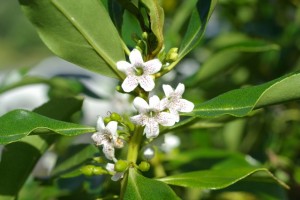 The ngaio is a fast-growing shrub or small tree (up to 10 metres) that thrives on the windy salt-laden conditions it finds on the West Coast. When young it forms a dome-shaped shrub, as it gets old branches break off so that the shape can become gnarled and distorted. It is excellent as a wind-break.
The ngaio is a fast-growing shrub or small tree (up to 10 metres) that thrives on the windy salt-laden conditions it finds on the West Coast. When young it forms a dome-shaped shrub, as it gets old branches break off so that the shape can become gnarled and distorted. It is excellent as a wind-break.
The somewhat fleshy leaves are long and shiny, with tiny white speckles during the spring and summer. These are translucent oil glands and Maori used these leaves, rubbed over the skin, to repel mosquitos. The young leaves can also be made into an infusion and used for the same purpose. The bell-shaped flowers are small and white, with lilac dots, and appear in November and December and sometimes April and May as well. They develop into red then purple berries and are easy to germinate. The ngaio also grows from cuttings.
Nihinihi shore or sea-bindweed or sand convolvulus
Calystegia soldanella
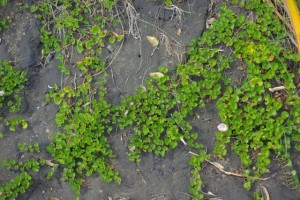 Nihinihi is a prostrate plant, a member of the convolvulus family, which grows in dunes on coastal beaches and around some inland lakes.
Nihinihi is a prostrate plant, a member of the convolvulus family, which grows in dunes on coastal beaches and around some inland lakes.
At North Piha it grows amongst Spinifex on foredunes well exposed to the Tasman Sea rollers, as well as further back into the back dunes, assisting in stabilising the highly dynamic dune system.
The stems of nihinihi often run under the sand and the fleshy, light-green leaves protrude above it. The leaves have a thick waxy coating which helps protect them against lashing wind and salt spray.
The leaves are green, roughly kidney-shaped and slightly cupped.
The stems and leaves can be completely covered in sand but will emerge through the sand layer.
A single plant can spread to form a patch about two metres in diameter.
The delicate flowers appear over summer and are trumpet-shaped, like those of convolvulus, and coloured white, pale pink or a very pale mauve.
Nihinihi provides colour and interest to dunes. However, they find it hard to compete with exotic invasive dune plants such as gazania, kikuyu and lupins.
Nikau
Rhopalostylis sapida family Palmaceae
The nikau palm is what gives the New Zealand coastal forest its distinctive tropical flavour. Nikau is the only palm of the New Zealand forest; it grows very slowly, but can ascend to a soaring height, and the trunks of old palms, such as those in the Nikau Glade at Piha, can be adorned with a rich variety of mosses, ferns, vines and epiphytes.
The distribution of nikau is wide, over the whole coastal area of the North Island and some of the South. The tall slender Karamea nikau on the West Coast of the South Island have attracted photographers and painters such as Stanley Palmer. While these nikau have been stranded in paddocks with the formation of pasture, the nikau normally grows deep in the shade of the forest.
The nikau starts with two-leafed seedlings that can form a thick grass under mature nikau. These are followed by regular nikau fronds which as the tree matures can be 3 metres long with a strong spine down the middle and opposite pairs of leaves all the way down the spine. This is actually a large single leaf which splits creating the fan-like effect.
A nikau can grow for up to 20 years before the trunk begins to form.
The base of the leaf frond wraps around the crown of the tree and is bulbous. This coracle shaped base of fallen fronds has served generations of children as a convenient place to sit and be pulled along by their mates or to slide down hills. Or it can be used for carrying things, as a basket.
As the old leaves drop off, often forming a dense litter under trees, the leaf scars form distinctive rings on the nikau trunk. The young trunk is green and the old trunk can be grey.
The flower bud of the nikau appears from just under the crown of leaves and emerges as one or two large pods known as spathes. These split open and the inflorescence unfolds. This is covered densely in small pink flowers which attract bees.
The following fruits are green then bright red and take about a year to ripen, consequently flowers and the year before’s seeds can be born at the same time. The berries are the size of a large pea and very hard.
This whole process is highly picturesque, and the ripe fruits are greatly loved by pigeon.
The green leaves of nikau were much used for making kete and for thatching by Maori and pakeha bushmen alike.



